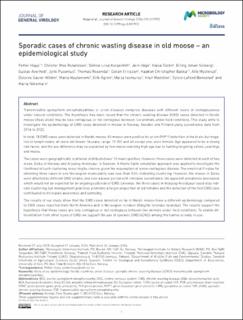| dc.contributor.author | Hopp, Petter | |
| dc.contributor.author | Rolandsen, Christer Moe | |
| dc.contributor.author | Korpenfelt, Sirkka-Liisa | |
| dc.contributor.author | Våge, Jørn | |
| dc.contributor.author | Sörén, Kaisa | |
| dc.contributor.author | Solberg, Erling Johan | |
| dc.contributor.author | Averhed, Gustav | |
| dc.contributor.author | Pusenius, Jyrki | |
| dc.contributor.author | Rosendal, Thomas | |
| dc.contributor.author | Ericsson, Göran | |
| dc.contributor.author | Bakka, Haakon Christopher | |
| dc.contributor.author | Mysterud, Atle | |
| dc.contributor.author | Gavier-Widén, Dolores | |
| dc.contributor.author | Hautaniemi, Maria | |
| dc.contributor.author | Ågren, Erik | |
| dc.contributor.author | Isomursu, Marja | |
| dc.contributor.author | Madslien, Knut | |
| dc.contributor.author | Benestad, Sylvie L. | |
| dc.contributor.author | Nöremark, Maria | |
| dc.date.accessioned | 2024-02-15T07:40:25Z | |
| dc.date.available | 2024-02-15T07:40:25Z | |
| dc.date.created | 2024-01-30T09:09:08Z | |
| dc.date.issued | 2024 | |
| dc.identifier.issn | 0022-1317 | |
| dc.identifier.uri | https://hdl.handle.net/11250/3117853 | |
| dc.description.abstract | Transmissible spongiform encephalopathies or prion diseases comprise diseases with different levels of contagiousness under natural conditions. The hypothesis has been raised that the chronic wasting disease (CWD) cases detected in Nordic moose (Alces alces) may be less contagious, or not contagious between live animals under field conditions. This study aims toinvestigate the epidemiology of CWD cases detected in moose in Norway, Sweden and Finland using surveillance data from 2016 to 2022. In total, 18 CWD cases were detected in Nordic moose. All moose were positive for prion (PrPres) detection in the brain, but negative in lymph nodes, all were old (mean 16 years; range 12–20) and all except one, were female. Age appeared to be a strong risk factor, and the sex difference may be explained by few males reaching high age due to hunting targeting calves, yearlings and males. The cases were geographically scattered, distributed over 15 municipalities. However, three cases were detected in each of two areas, Selbu in Norway and Arjeplog-Arvidsjaur in Sweden. A Monte Carlo simulation approach was applied to investigate the likelihood of such clustering occurring by chance, given the assumption of a non-contagious disease. The empirical P-value for obtaining three cases in one Norwegian municipality was less than 0.05, indicating clustering. However, the moose in Selbu were affected by different CWD strains, and over a 6 year period with intensive surveillance, the apparent prevalence decreased, which would not be expected for an ongoing outbreak of CWD. Likewise, the three cases in Arjeplog-Arvidsjaur could also indicate clustering, but management practices promotes a larger proportion of old females and the detection of the first CWD case contributed to increased awareness and sampling. The results of our study show that the CWD cases detected so far in Nordic moose have a different epidemiology compared to CWD cases reported from North America and in Norwegian reindeer (Rangifer tarandus tarandus). The results support the hypothesis that these cases are less contagious or not contagious between live animals under field conditions. To enable differentiation from other types of CWD, we support the use of sporadic CWD (sCWD) among the names already in use. Alces alces; epidemiology; Nordic countries; prion disease; sporadic chronic wasting disease (sCWD); transmissible spongiform encephalopathies. | |
| dc.language.iso | eng | |
| dc.title | Sporadic cases of chronic wasting disease in old moose – an epidemiological study | |
| dc.title.alternative | Sporadic cases of chronic wasting disease in old moose – an epidemiological study | |
| dc.type | Peer reviewed | |
| dc.type | Journal article | |
| dc.description.version | publishedVersion | |
| cristin.ispublished | true | |
| cristin.fulltext | original | |
| cristin.qualitycode | 1 | |
| dc.identifier.doi | 10.1099/jgv.0.001952 | |
| dc.identifier.cristin | 2237860 | |
| dc.source.journal | Journal of General Virology | |
| dc.source.volume | 105 | |
| dc.relation.project | Andre: ICRAD: ‘Tackling Chronic Wasting Disease in Europe: 322907 | |
| dc.relation.project | Veterinærinstituttet: 12081 | |
| dc.relation.project | Miljødirektoratet: CWD surveillance in Norway, Sweden and Finland | |
| dc.relation.project | Miljødirektoratet: 17 070 060 | |
| dc.relation.project | Andre: Swedish Board of Agriculture | |
| dc.relation.project | Andre: Finnish Food Authority | |
| dc.relation.project | Andre: Norwegian Food Safety Authority | |
| dc.relation.project | Andre: Ministry of Agriculture and Forestry | |
| dc.relation.project | Miljødirektoratet: 22087484 | |
| dc.subject.nsi | VDP::Zoologiske og botaniske fag: 480 | |
| dc.subject.nsi | VDP::Zoology and botany: 480 | |
| dc.subject.nsi | VDP::Zoologiske og botaniske fag: 480 | |
| dc.subject.nsi | VDP::Zoology and botany: 480 | |
